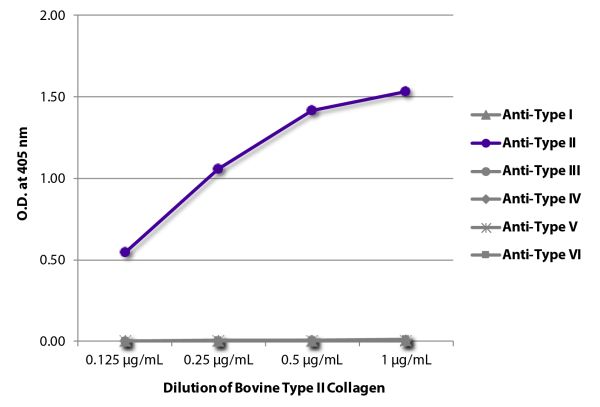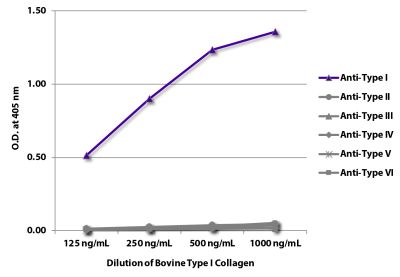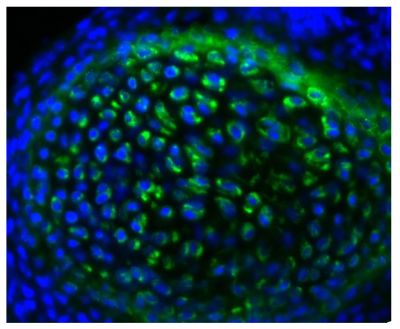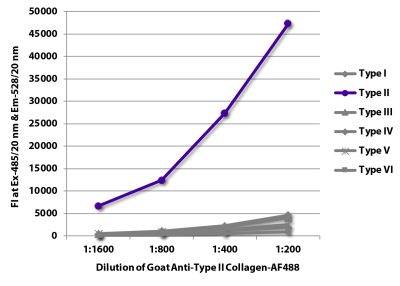Bovine Type II Collagen-Lyophilized
Cat. No.:
1220-02
Purified Bovine Type II Collagen (lyophilized) for use as a coating material and standard.
$183.00


| Description | Collagen is the main structural protein in the extracellular space and is the most abundant protein in the ECM. Collagens are divided into two classes - fibril (types I, II, III, V) and non-fibril (types IV, VI). Type II collagen is the main component of cartilage and mutations are associated several types of chondrodysplasia. Type II collagen is formed by homotrimers of α1(II) chains. |
|---|---|
| Source | Cartilage |
| Purity | > 90% by SDS-PAGE |
| Purification Method | Controlled and limited pepsin digestion followed by selective salt precipitation |
| Buffer Formulation | Lyophilized from 500 mM acetic acid |
| Recommended Storage | 2-8°C |
| Applications |
ELISA – Quality tested 1,10 SDS-PAGE – Quality tested 2 Western Blot – Reported in literature 3,4 In vivo Assays – Reported in literature 5-8 Coating Material for – ECM Interaction Studies – Reported in literature 9 Migration Studies – Reported in literature 10 |
Documentation
Certificate of Analysis Lookup
Enter the Catalog Number and Lot Number for the Certificate of Analysis you wish to view
- 1. Frenz DA, Liu W, Williams JD, Hatcher V, Galinovic-Schwartz V, Flanders KC, et al. Induction of chondrogenesis: requirement for synergistic interaction of basic fibroblast growth factor and transforming growth factor-beta. Development. 1994;120:415-24. (ELISA, Standard Curve)
- 2. Geng Y, McQuillan D, Roughley PJ. SLRP interaction can protect collagen fibrils from cleavage by collagenases. Matrix Biol. 2006;25:484-91. (SDS-PAGE)
- 3. Patti JM, Jonsson H, Guss B, Switalski LM, Wiberg K, Lindberg M, et al. Molecular characterization and expression of a gene encoding a Staphylococcus aureus collagen adhesin. J Biol Chem. 1992;267:4766-72. (WB)
- 4. Lee ER, Lamplugh L, Kluczyk B, Leblond CP, Mort JS. Neoepitopes reveal the features of type II collagen cleavage and the identity of a collagenase involved in the transformation of the epiphyses anlagen in development. Dev Dyn. 2009;238:1547-63. (WB)
- 5. Little RG II, Gazzano-Santoro H, Parent JB, inventors; Xoma Corporation, assignee. Therapeutic uses of bactericidal/permeability increasing protein products. United States patent US 1994/5348942A. 1994 Sep 20. (In vivo Assays)
- 6. Burlingham WJ, Love RB, Jankowska-Gan E, Haynes LD, Xu Q, Bobadilla JL, et al. IL-17-dependent cellular immunity to collagen type V predisposes to obliterative bronchiolitis in human lung transplants. J Clin Invest. 2007;117:3498-506. (In vivo Assays)
- 7. Iwai K, Ishii M, Ohshima S, Miyatake K, Saeki Y. Abundant expression of tetraspanin CD9 in activated osteoclasts in ovariectomy-induced osteoporosis and in bone erosions of collagen-induced arthritis. Rheumatol Int. 2008;28:225-31. (In vivo Assays)
- 8. Dart ML, Jankowska-Gan E, Huang G, Roenneburg DA, Keller MR, Torrealba JR, et al. Interleukin-17-dependent autoimmunity to collagen type V in atherosclerosis. Circ Res. 2010;107:1106-16. (In vivo Assays)
- 9. Hocking AM, Strugnell RA, Ramamurthy P, McQuillan DJ. Eukaryotic expression of recombinant biglycan. Post-translational processing and the importance of secondary structure for biological activity. J Biol Chem. 1996;271:19571-7. (Coating, ECM Interaction Studies)
- 10. Hidaka C, Cheng C, Alexandre D, Bhargava M, Torzilli PA. Maturational differences in superficial and deep zone articular chondrocytes. Cell Tissue Res. 2006;323:127-35. (ELISA, Standard Curve, Coating, Migration Studies)
See More






